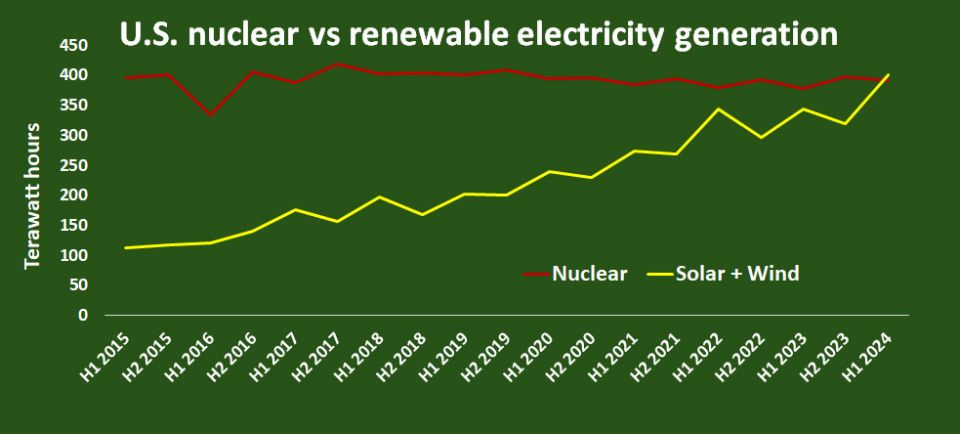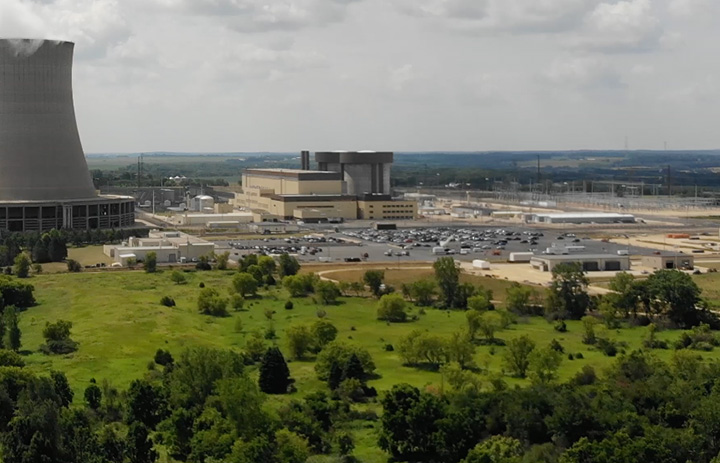Are Nuclear Plant Closures Due to Market Manipulation and Decommissioning Fund Rules?
 Most of you are well aware that Entergy recently announced it will permanently close its Vermont Yankee (VY) nuclear plant. The primary reasons given were continued low natural gas prices, the cost of post-Fukushima upgrades, and "flaws" in the local wholesale electricity market that suppress prices and harm the profitability of baseload facilities like VY. VY was close to breaking even this year, as well as the last few years, but was projected to become unprofitable in the future-over the next few years, anyway.
Most of you are well aware that Entergy recently announced it will permanently close its Vermont Yankee (VY) nuclear plant. The primary reasons given were continued low natural gas prices, the cost of post-Fukushima upgrades, and "flaws" in the local wholesale electricity market that suppress prices and harm the profitability of baseload facilities like VY. VY was close to breaking even this year, as well as the last few years, but was projected to become unprofitable in the future-over the next few years, anyway.
Questions
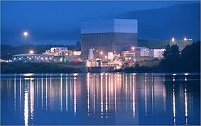 Many of us are having a hard time understanding this decision, especially given that the utility had just spent a lot of money on plant upgrades as well as legal battles with the state of Vermont, which had been trying to close the plant. Why would Entergy do all that if the plant was marginal, or if they weren't planning on keeping it open for a long time?
Many of us are having a hard time understanding this decision, especially given that the utility had just spent a lot of money on plant upgrades as well as legal battles with the state of Vermont, which had been trying to close the plant. Why would Entergy do all that if the plant was marginal, or if they weren't planning on keeping it open for a long time?
Some have speculated that they went to the trouble of fighting (and winning) the legal battles in order to set legal precedent for other, larger, more important plants in the region that face similar legal challenges (e.g., Indian Point). The investments in the plant, however, remain harder to explain.
Others have more general questions about the closure decision itself, as opposed to the recent expenditures. Many expect natural gas prices to rise in a few years, for many reasons. The decision to close a plant over a few years of (slight) unprofitability seems short-sighted. Is it just a case of extreme short-term mindset? Or is it, as some have speculated, a means of increasing the utility's overall profitability in the region by raising market electricity prices, by reducing supply and having gas be the last incremental supplier a larger fraction of the time?
Finally, it could have to do with the way decommissioning funds are treated, financially. It seems that closing a plant and accessing the decommissioning fund can actually financially benefit a utility-on the books, anyway. It's not clear to me how this works (I'm not an accountant).
Market design
 One growing issue in the United States is "negative pricing," where the market price for power, in deregulated markets, can fall below zero. That is, some suppliers will actually pay the grid to take their power. Most of the time, the suppliers in question are wind farms that receive heavy subsidies in the form of federal tax credits (of 2.2 cents/kW-hr) and, in the case of New England, regional Renewable Energy Credits that can be as high as ~6 cents/kW-hr, as discussed in Meredith Angwin's very informative post at Yes Vermont Yankee. This allows them to still be profitable, even at a negative price.
One growing issue in the United States is "negative pricing," where the market price for power, in deregulated markets, can fall below zero. That is, some suppliers will actually pay the grid to take their power. Most of the time, the suppliers in question are wind farms that receive heavy subsidies in the form of federal tax credits (of 2.2 cents/kW-hr) and, in the case of New England, regional Renewable Energy Credits that can be as high as ~6 cents/kW-hr, as discussed in Meredith Angwin's very informative post at Yes Vermont Yankee. This allows them to still be profitable, even at a negative price.
As Meredith points out, one of the factors that affected Entergy's decision was the fact that the regional grid operator had just decided to allow negative pricing. That is one source of the projected decline in VY's profitability in coming years. Another factor was Vermont's decision to not buy any power from the plant, even though the plant was offering power at ~5 cents/kW-hr and Vermonter's pay almost 20 cents/kW-hr for power. That required the plant to sell (export) its power elsewhere in the regional market, which presumably reduced the price they could get. Finally, the market did not provide VY with any credit for the capacity it provides for the benefit of grid stability and margin, or for the non-polluting, non-CO2 emitting nature of its power. In fact, the grid operator will provide $78 million in capacity payments to keep some old (polluting) oil-fired generators in the region on-line and available. If $78 million per year were given to VY, that would equate to a benefit of ~$16/MW-hr, enough to make a huge difference.
Political motivations?
 Many of us can't help but see some political motivation in these electricity market design decisions. The VY protestors and the state's direct legal challenges may have lost their battles, but it seems that the war was won by different means and (perhaps) by people in even higher places. The direct challenges failed, but the state and regional grid operator managed to render the plant unprofitable through power market manipulation and the state's refusal to buy the plant's power.
Many of us can't help but see some political motivation in these electricity market design decisions. The VY protestors and the state's direct legal challenges may have lost their battles, but it seems that the war was won by different means and (perhaps) by people in even higher places. The direct challenges failed, but the state and regional grid operator managed to render the plant unprofitable through power market manipulation and the state's refusal to buy the plant's power.
Changes are being made to rules governing power grids that seem to be deliberately designed to harm the profitability of baseload (i.e., coal and nuclear) power plants. John Wellinghoff, the head of the Federal Energy Regulatory Commission (which is involved with issues related to power grids and markets), has often proclaimed that baseload power is a thing of the past that is no longer needed. Well, it seems like his vision may be coming true, some of this likely due to the policy changes discussed above. These changes will act to reduce the role of coal and nuclear baseload plants and replace them with "flexible" gas generation capacity.
The "plan" is as follows: Erect a large amount of intermittent renewable capacity (mainly wind), essentially by government fiat, through heavy subsidies and/or mandates. Then, when these intermittent sources dump large amounts of power on the grid (most often at times of low demand), this will drive market prices down to zero (or lower). Due to large operating subsidies, these sources can continue to profit at zero/negative prices. Then, allow negative pricing on the grid. This will significantly harm the finances of baseload plants (nuclear especially) that have significant fixed operating expenses that remain nearly constant even if the plant is turned off.
Negative pricing will never affect gas plants, since most of their operating cost is fuel. When power prices go to zero (or negative), they simply shut down, at little financial loss. Natural gas plants would never bid zero for power in the first place, so allowing negative pricing clearly was never going to affect them. It does, however, affect nuclear and coal plants.
Despite all the above, the New England grid operator claims that it is concerned about over-reliance on natural gas generation in the region, and has said that the negative pricing was allowed to increase fuel diversity. Ostensibly, the argument must be that it provides some (more) encouragement for the use of renewable sources, in lieu of gas. But for anyone with any real understanding of the power markets and the impacts of such policies, those statements sound outright dishonest. They must know that the real, main impact of policies like negative pricing is to drive coal and nuclear generation down and replace it with gas, making the dependency on gas higher, not lower. The grid operator's decision to provide capacity payments (financial support) of $78 million to oil-fired backup capacity, but not to VY, also seems highly suspect in this context.
Broader issues
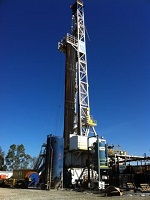 While we claim to care about global warming and health impacts from power production, policies in the United States, and even more so in Europe, essentially only support renewable energy production, through heavy subsidies and outright mandates for their use. Policy makes no distinction among non-renewable sources no matter how great the differences are between them in terms of health or environmental consequence. The moment a coal plant is even 0.1 cent/kW-hr cheaper, it is turned on in place of a gas (or nuclear) plant, no matter how much higher its environmental costs are. While nuclear has to spend enormous amounts to minimize its potential negative impacts, it receives no financial credit at all for its non-polluting benefits, as the industry policy organization Nuclear Energy Institute points out.
While we claim to care about global warming and health impacts from power production, policies in the United States, and even more so in Europe, essentially only support renewable energy production, through heavy subsidies and outright mandates for their use. Policy makes no distinction among non-renewable sources no matter how great the differences are between them in terms of health or environmental consequence. The moment a coal plant is even 0.1 cent/kW-hr cheaper, it is turned on in place of a gas (or nuclear) plant, no matter how much higher its environmental costs are. While nuclear has to spend enormous amounts to minimize its potential negative impacts, it receives no financial credit at all for its non-polluting benefits, as the industry policy organization Nuclear Energy Institute points out.
One of the main paradigms for future power generation involves using renewables to the highest extent practical (largely by political mandate) and to use natural gas plants that can ramp up and down quickly to back up the highly variable renewable power for most of the rest. Renewables' practical limitations will likely limit them to ~25 percent, so gas would be used for up to ~75 percent of overall power generation (way up from the ~20 percent it used to be). This approach is loved by "environmentalists" and also by the oil/gas industry, which happens to be by far the most powerful and influential of the energy industries. They would have a significant interest in taking market share now provided by nuclear and coal. A renewables-heavy future would not diminish, but rather increase and enshrine gas (and oil's) role in power generation, in that only their plants can back up intermittent renewables. The removal of fossil fuels from the power generation sector, as happened in France, would be avoided.
Perhaps unsurprisingly, everything seems to be going the wind/gas paradigm's way recently. Coal is being significantly affected by environmental rules for new and existing plants promulgated by the Obama administration (that I also support). Meanwhile, nuclear is subject to even more (post-Fukushima) requirements and is treated to an endless stream of hyped up reporting by the media (on Fukushima, etc.) that portray minor nuclear risks/impacts as existential threats, while ignoring vastly larger health risks from fossil fuels. Nuclear is also required to spend large amounts on security to be able to repel a large group of attackers, with some trying to argue that even this is not enough. No such requirements are placed on hydro dams, chemical plants, tall buildings, or events where large numbers of people are gathered, despite the fact that a successful attack on any of those structures/venues would actually lead to a greater loss of life. Meanwhile, significant reductions in regulatory requirements (i.e., blanket exemption from the Clean Water and Safe Drinking Water Acts) have resulted in a significant reduction in the price of natural gas through fracking. As expected, this all has resulted in large market share gains for gas and renewables.
What can help?
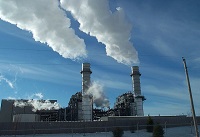 Policies that aid renewable sources, in the name of reducing air pollution and global warming, will not help those goals if they result in non-emitting nuclear production being shut down. Even the replacement of nuclear with an equal amount of renewables provides no net benefit. However, it seems that these policies (especially ones like negative pricing) may result in the retirement of far more nuclear generation than the amount of any increased renewable generation they stimulate. Thus, their effect may be negative. Policies must be modified so that this doesn't happen. Also, while the seemingly short-term focus of these utilities is unfortunate, financial incentives to keep such plants open are called for. In terms of reducing CO2 emissions over the long-term, I can think of no more cost-effective investment than incentives to keep marginal nuclear plants open through (brief) periods of low natural gas and market power prices.
Policies that aid renewable sources, in the name of reducing air pollution and global warming, will not help those goals if they result in non-emitting nuclear production being shut down. Even the replacement of nuclear with an equal amount of renewables provides no net benefit. However, it seems that these policies (especially ones like negative pricing) may result in the retirement of far more nuclear generation than the amount of any increased renewable generation they stimulate. Thus, their effect may be negative. Policies must be modified so that this doesn't happen. Also, while the seemingly short-term focus of these utilities is unfortunate, financial incentives to keep such plants open are called for. In terms of reducing CO2 emissions over the long-term, I can think of no more cost-effective investment than incentives to keep marginal nuclear plants open through (brief) periods of low natural gas and market power prices.
The fundamental problem is that while nuclear pays dearly to reduce any potential negative impacts/risks to negligible levels, it gets absolutely no financial credit for the fact that it emits no pollution or CO2. Ideally, policy should treat both new and existing nuclear capacity the same as renewables. (I formerly thought that existing plants didn't need any support since they would continue to operate anyway; something which appears to not be the case.) Also, ideally we would tax negative impacts like air pollution or CO2 emissions, as opposed to subsidizing or mandating sources that are politically determined to be clean. Either of the above would eliminate all the problems that these old plants are having, or any issues associated with zero/negative pricing (which would never occur).
The above policies may be a long time coming, so here are some more practical ideas:
Negative pricing simply needs to go away. It's unjust and does not accomplish its goals. It may even increase air pollution and CO2 emissions, by causing nuclear plants to close, and it definitely reduces fuel diversity by fostering an over-reliance on gas. Nuclear should also definitely qualify for any "capacity payments" in the market.
Subsidies for renewables, wind in particular, should be phased out, especially given the maturity of the wind industry. The wind industry even offered to have subsidies phase out over the next six years, but no action on such a proposal has been taken yet. The credit should be phased out for both new and existing wind turbines.
Steps should be taken to reduce the fixed costs of nuclear plant operation. Some utilities are starting to focus on ways to reduce costs (and yes, this means reducing staffing, with nuclear's staff levels being far higher than other sources). As I discuss above, I feel that nuclear's security requirements are unjustly strict. However, cost saving from any reductions will only be on the order of a fraction of a cent/kW-hr. Many requirements (including security) appear to be independent of plant size. Perhaps the Nuclear Regulatory Commission could consider scaling back some requirements for smaller plants, based on their smaller potential release.
Decommissioning fund rules should be revised so that it never actually helps the utility, financially, to close a plant and "officially" tap into the decommissioning fund. I'm a bit vague on what the details would be, as it's somewhat arcane and I'm not an accountant. But I know what the result should be. The decommissioning fund should not provide any kind of artificial incentive to close a plant.
Finally, various types of financial support for marginal nuclear plants could be considered by federal, state or local governments. I discuss these options in a previous ANS Nuclear Cafe post. If the decision is marginal, a relatively small amount of financial support could make the difference, and it may be in the interests of state or local governments to do so (to retain employment and local tax base). The incentive for the federal government would be that it would constitute just about the cheapest way ever imagined to reduce CO2 emissions over the long-term (much more effective than renewables subsidies).
Mothballing plants
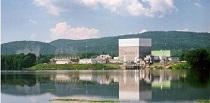 Finally, changes need to be made so that it's economical and practical to mothball a nuclear plant and restart it later, as Rod Adams discussed in this ANS Nuclear Cafe post. Giving up a plant's operating license causes the NRC fee of $4.4 million per year (per plant) to mostly disappear. I believe that a similar reduction should also apply for a mothballed plant, but that fee only costs a plant, like VY, on the order of 0.1 cents/kW-hr, so the reduced fee is not likely to be a significant factor.
Finally, changes need to be made so that it's economical and practical to mothball a nuclear plant and restart it later, as Rod Adams discussed in this ANS Nuclear Cafe post. Giving up a plant's operating license causes the NRC fee of $4.4 million per year (per plant) to mostly disappear. I believe that a similar reduction should also apply for a mothballed plant, but that fee only costs a plant, like VY, on the order of 0.1 cents/kW-hr, so the reduced fee is not likely to be a significant factor.
Theoretically, staffing costs (including security) should not be much different between a mothballed and a permanently shutdown plant, since the physical plant configuration (and any risks, etc.) is no different. The only difference would be additional costs from decommissioning activities at the shutdown plant, which would be paid for by the decommissioning fund.
If NRC requirements demand much higher staffing levels for a mothballed plant than for a permanently closed plant (simply because it still officially has its operating license) those requirements need to change. They are unjustified, since there are no actual differences in the plant. The only additional burden I can see for the mothballed plant would be some inspections and maintenance to keep the plant components in operable condition, but I can't see that being a very large cost.
As Rod suggests, if a plant is mothballed, they should be able to defer any industry-wide (e.g., Fukushima) plant upgrades until they want to start the plant. However, a mothballed older plant should not be required to "bring itself up to the latest standards" that would apply for a new plant, in order to restart. Upgrades should be limited to what the NRC would have demanded of the plant if it had never stopped operating. Again, theoretically they wouldn't have to do any such things if they maintained their operating license and paid the $4.4 million fee.
Given all the above, it continues to be difficult to see why a utility would close a nuclear plant and give up its operating license, given that the (fixed) costs for a mothballed plant shouldn't be much higher than those of a permanently shutdown plant. The reduction in the ($4.4. million) NRC fee doesn't seem to be enough to explain it. Signs point to the decommissioning fund, and the apparent financial benefits (on paper) of tapping into it. Perhaps some specific changes to decommissioning fund accounting rules should be the highest priority for near-term policy adjustments.

______________________

Hopf
Jim Hopf is a senior nuclear engineer with more than 20 years of experience in shielding and criticality analysis and design for spent fuel dry storage and transportation systems. He has been involved in nuclear advocacy for 10+ years, and is a member of the ANS Public Information Committee. He is a regular contributor to the ANS Nuclear Cafe.



.png)
